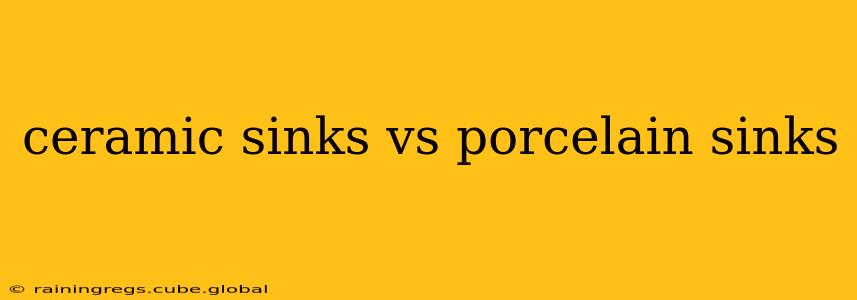Choosing the right sink for your bathroom can feel overwhelming. With a plethora of materials available, it's easy to get lost in the details. Two popular choices often top the list: ceramic and porcelain sinks. While seemingly similar, key differences exist that significantly impact durability, maintenance, and overall aesthetic. This comprehensive guide delves into the nuances of ceramic versus porcelain sinks, helping you make an informed decision for your home.
What is a Ceramic Sink?
Ceramic sinks are made from clay fired at high temperatures. This process creates a durable, non-porous material. However, the term "ceramic" is quite broad. Many sinks labeled "ceramic" are actually made from a blend of materials, including clay and other minerals. This can affect the sink's final properties, such as its resistance to chipping or staining. The beauty of ceramic lies in its versatility; it can be molded into various shapes and styles, offering a wide range of design options.
What is a Porcelain Sink?
Porcelain sinks are a specific type of ceramic sink. The key difference lies in the manufacturing process. Porcelain sinks are crafted from a refined, high-quality clay mixture, fired at even higher temperatures than standard ceramic sinks. This higher firing temperature creates a denser, harder, and more durable material with a smoother, glossier finish. Porcelain is renowned for its exceptional resistance to chipping, staining, and scratching, making it a popular choice for high-traffic areas.
Ceramic Sink vs. Porcelain Sink: Key Differences
| Feature | Ceramic Sink | Porcelain Sink |
|---|---|---|
| Material | Clay and other minerals (variable composition) | Refined, high-quality clay mixture |
| Durability | Moderately durable, susceptible to chipping and staining | Highly durable, resistant to chipping and staining |
| Cost | Generally less expensive | Generally more expensive |
| Maintenance | Requires more regular cleaning | Easier to clean and maintain |
| Finish | Can vary; may be less glossy | Typically has a smooth, glossy finish |
| Weight | Lighter | Can be heavier |
What are the Pros and Cons of Each?
Ceramic Sinks: Pros and Cons
Pros:
- Affordability: Ceramic sinks generally come with a lower price tag than porcelain sinks.
- Variety of Styles: Offers a wide range of shapes, colors, and designs.
Cons:
- Lower Durability: More prone to chipping, scratching, and staining compared to porcelain.
- Higher Maintenance: Requires more frequent cleaning to prevent staining and discoloration.
Porcelain Sinks: Pros and Cons
Pros:
- Exceptional Durability: Highly resistant to chips, scratches, and stains.
- Easy Maintenance: Simple to clean and maintain, retaining its appearance for longer periods.
- Elegant Finish: Usually features a smooth, glossy finish that enhances bathroom aesthetics.
Cons:
- Higher Cost: Porcelain sinks tend to be more expensive than ceramic sinks.
- Less Design Variety (Sometimes): While high-end porcelain offers diverse designs, the basic options might be less varied than ceramic.
Which Type of Sink is Better?
The "better" sink depends entirely on your individual needs and priorities. If budget is a major concern and you are willing to invest more time in cleaning, a ceramic sink might suffice. However, if durability, ease of maintenance, and a luxurious look are paramount, a porcelain sink is the superior choice, justifying the higher price tag.
Are Porcelain Sinks More Durable Than Ceramic Sinks?
Yes, porcelain sinks are generally more durable than ceramic sinks due to the higher firing temperature and the use of a more refined clay mixture. This results in a denser, harder material that better resists chipping, scratching, and staining.
How Do I Clean a Ceramic or Porcelain Sink?
Both ceramic and porcelain sinks benefit from regular cleaning. A simple solution of warm water and mild dish soap is usually sufficient. Avoid abrasive cleaners and scouring pads, which can damage the surface. For stubborn stains, a non-abrasive cleaner specifically designed for sinks can be used.
What is the Difference Between Vitreous China and Porcelain?
Vitreous china is a type of ceramic that is similar to porcelain but generally less durable and has a lower water absorption rate. While the distinction can be subtle, porcelain tends to be denser and more resistant to stains and damage.
Ultimately, the choice between a ceramic and porcelain sink hinges on your budget, desired level of durability, and aesthetic preferences. Weigh the pros and cons carefully, considering your lifestyle and priorities, to ensure you select the perfect sink for your bathroom.
